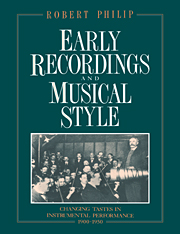8 - Implications for the nineteenth century
Published online by Cambridge University Press: 22 September 2009
Summary
INTRODUCTION
One of the reasons for writing this book is a belief that early twentieth-century recordings can shed new light on the performing styles of the nineteenth century. The most obvious link is that many of the musicians who performed on early recordings were brought up in the nineteenth century, and their playing must include remnants of nineteenth-century style. The fact, for example, that Ysaÿe studied under Vieuxtemps and Wieniawski, and that Joachim played under Mendelssohn and was associated with Brahms, gives particular importance to their recordings. But the recordings of the early twentieth century have a more general relevance to nineteenth-century practice. Stated at its simplest, it is that none of the aspects of early twentieth-century style described in this book can have arisen overnight.
In the use of vibrato and portamento, in flexibility of tempo, and in detailed rhythmic style, the performers of the early twentieth century can be heard moving towards what we now think of as modern style, and away from earlier practice – that is, the practice of the nineteenth century. This is no more than a statement of the obvious. In any period, performance is in a state of transition from the past to the future, and the early twentieth century is no exception. The difficult question, and the question of most interest to students of historical performance practice, is what aspects of early twentieth-century performance can be identified as surviving from the nineteenth century.
- Type
- Chapter
- Information
- Early Recordings and Musical StyleChanging Tastes in Instrumental Performance, 1900–1950, pp. 207 - 228Publisher: Cambridge University PressPrint publication year: 1992



